Alien Worlds: Exoplanets in Pictures
Astronomers have discovered hundreds of planets orbiting other stars, but only a few have been seen in photographs
Astronomers have discovered more than 850 planets orbiting other stars. These exoplanets are found using a variety of techniques, but most are indirect—we see the effect of the planet on its host star, but we don’t see the planet itself.
However, a very few handful have actually been directly detected—small sparks of light visible next to the brilliant spotlights of their stars. On this page are pictures all the exoplanets we’ve been able to see so far, including other solar systems, and some planets caught in motion as they orbit their parent stars.
The First Exoplanet
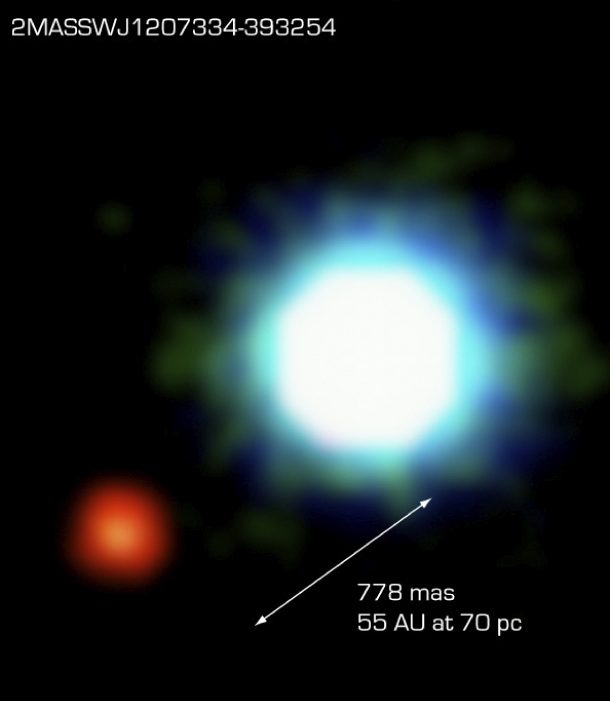
Photo by ESO.
The first-ever direct picture of an exoplanet came in 2005. Well, kinda: The planet was seen in 2004 but astronomers had to wait a year to confirm it wasn’t a background star or galaxy. The planet is called 2MASSWJ1207334-3932b, or 2M1207b for short, and is about 230 light-years from Earth. In this image, taken in infrared light using the European Southern Observatory’s Very Large Telescope, the planet is the dull red spot near its much brighter parent star. Or “star,” I should say: That brighter object is a brown dwarf, something more massive than a planet but not really a full-fledged star, either. Still, the planet itself is about five times the mass of Jupiter, placing it firmly in the planetary mass range, and securing its place in history as the first exoplanet ever directly detected.
Sauron's Planet
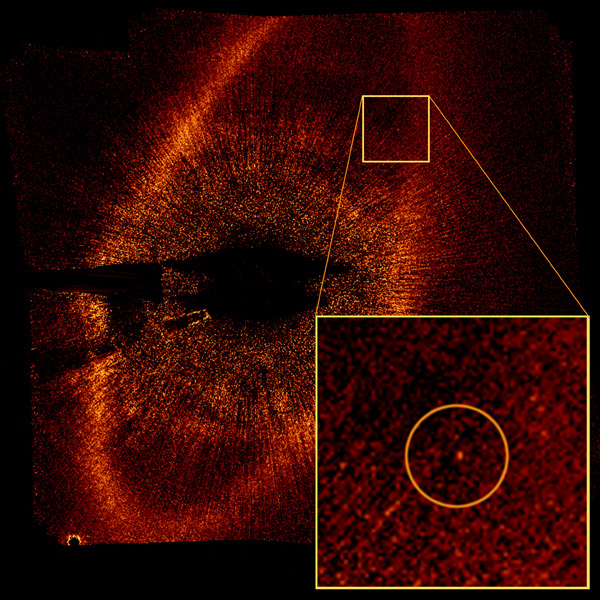
Photo by NASA,ESA, P. Kalas, J. Graham, E. Chiang, E. Kite (University of California, Berkeley), M. Clampin (NASAGoddard Space Flight Center), M. Fitzgerald (Lawrence Livermore National Laboratory), and K. Stapelfeldt and J. Krist (NASAJet Propulsion Laboratory).
Fomalhaut is a star only about 25 light-years from us, making it our galactic next-door neighbor. It’s pretty bright, easily visible to the naked eye, and in fact is the 18th brightest star in the night sky. In this Hubble Space Telescope image, the overwhelming light from the star has been blocked out, revealing that it’s surrounded by a huge ring of dust 36 billion kilometers across. It’s the Eye of Sauron!
Just inside that ring is a tiny spark of light, first seen in 2004. It was observed again in 2006, making it clear it was actually orbiting Fomalhaut, and was formally announced as a planet in 2008. However, it’s somewhat controversial: Subsequent observations show it may actually be a clump of dust, like a cosmic dust bunny, and not a planet at all. Another group of researchers thinks there actually is a planet in there surrounded by the cloud of dust. At the moment, its status as a planet is not confirmed. I include it here for historical sake, since it was the first exoplanet announced around an actual star, and may yet turn out to be a planet.
Orbital Motion
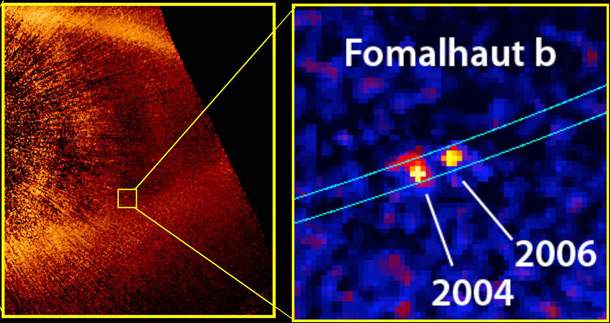
Photo by Paul Kalas, U.C.-Berkeley.
This picture is a composite of two observations of Fomalhaut using Hubble, showing the purported planet’s motion over two years. These images indicate that whatever it is—planet or dust cloud—it’s really there and not some camera artifact.
The First Exosolar System
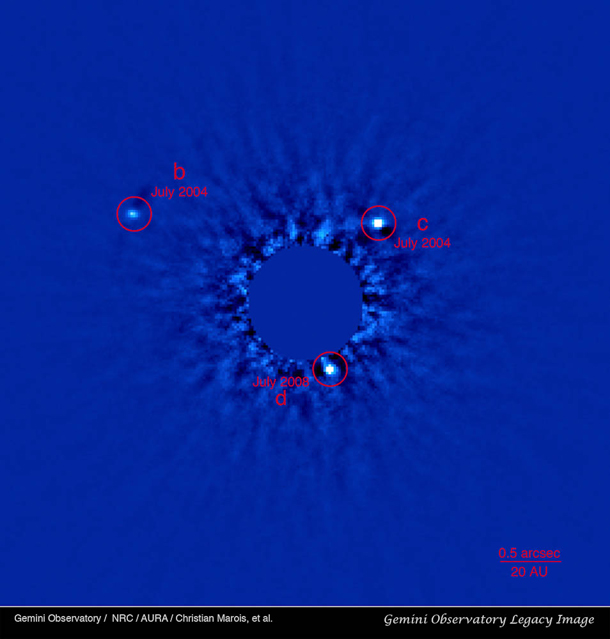
Photo by Gemini Observatory.
HR8799 is a star a bit more massive than the Sun, and far younger, about 60 million years old. While it may not be as photogenic as Fomalhaut, it more than makes up for it in this image from the Gemini Observatory, because we see not one but three planets orbiting it. This is the first portrait of an exosolar system! It was announced at the same time as the Fomalhaut candidate, too, giving this system a tie as the first ever seen orbiting a Sun-like star.
The planets, labeled b, c, and d, are about 7, 10, and 10 times the mass of Jupiter, respectively, and orbit their star at 68, 38, and 24 times the distance of the Earth from the Sun. It’s possible planets c and d are massive enough to qualify as brown dwarfs (an intermediate object between stars and planets), but it’s still unclear.
If you don’t want include possible brown dwarfs as planets, that’s OK, because the HR8799 system still counts as a bona fide solar system, though. How? Because of the next picture.
A Fourth for HR8799
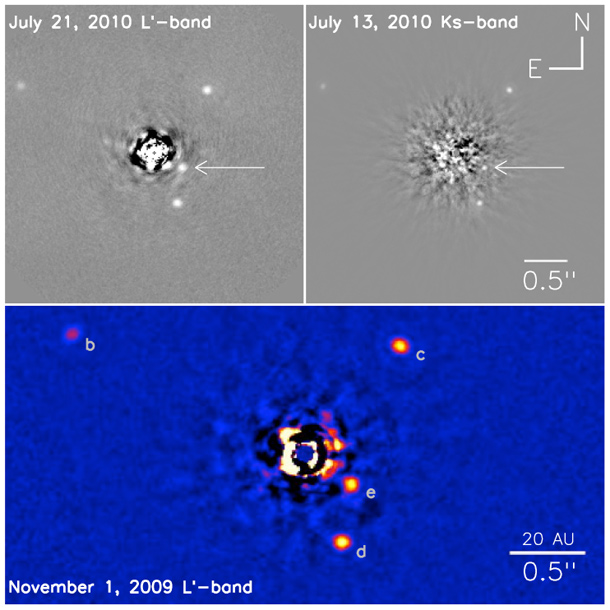
Photo by NRC-HIA, Christian Marois, and the W.M. Keck Observatory.
These images, taken in July 2010 using the monster ten-meter Keck II telescope in Hawaii, show HR8799 has a fourth companion! HR8799e is about seven times the mass of Jupiter, clearly making it a planet. It orbits the star about 2.2 billion kilometers out—about the same distance as Uranus from the Sun.
Hiding in Plain Sight
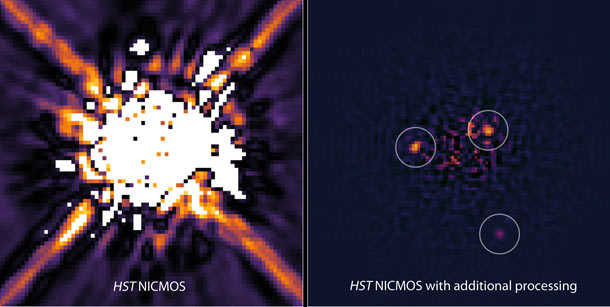
Photo by NASA, ESA, and R. Soummer (STScI).
Fate can be funny sometimes. HR8799 was observed using Hubble in 1998, but no planets were found. Once planets were discovered to be near the star in 2008, astronomers went back to the Hubble images and used more sophisticated analysis techniques developed over the previous decade to look more carefully. Sure enough, there they were. So in a sense, this is the first image ever taken of exoplanets around a Sun-like star. We just didn’t know it!
The Coldest Exoplanet
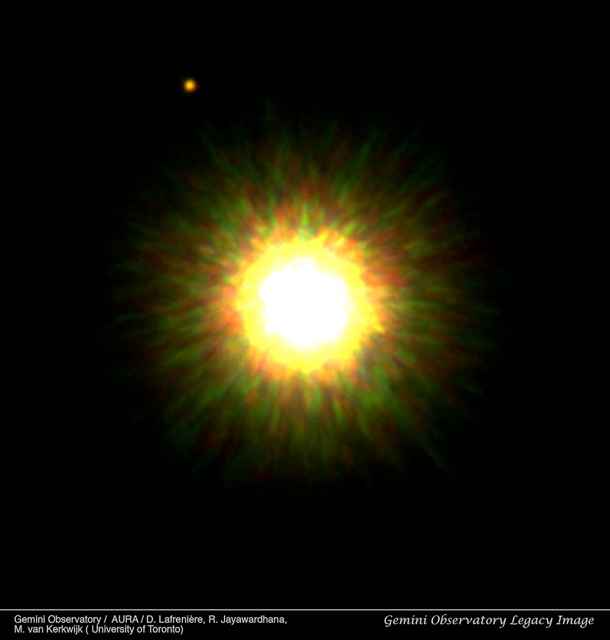
Photo by Gemini Observatory.
One of the clearest images of an exoplanet shows the prosaically named star 1RXS J160929.1-210524 and its planet, which has about eight times the mass of Jupiter. One reason it’s so easy to spot the planet is that it’s very far from its star: It orbits a whopping 50 billion kilometers (30 billion miles) out—roughly ten times farther out than Neptune orbits the Sun! Current models of how planets form around stars have a very tough time putting a planet this massive that far out. It’s possible an encounter with a more massive planet too close to the star to see tossed this one out to its current distance.
Planet in the Dust
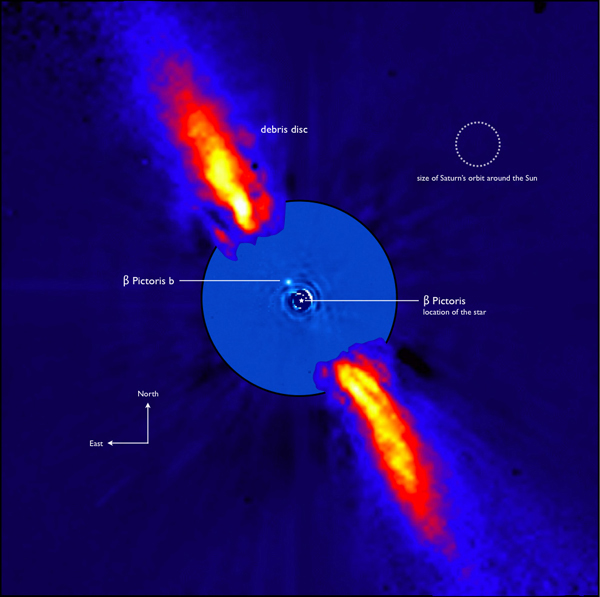
Photo by ESO.
Observations of the nearby star Beta Pictoris in the 1980s showed it had a thick disk of material orbiting it, but it wasn’t until November 2008 that the detection of a planet was confirmed. This image, taken in 2003 using the Very Large Telescope, shows the planet very close to the star, just above it and to the left (special techniques were used to prevent the far brighter starlight from overexposing the camera). The disk, which we see edge-on, is obvious. The planet’s orbit is roughly the same size as Saturn’s, and takes 15 years to orbit the star.
Speaking of which …
Half an Orbit Later
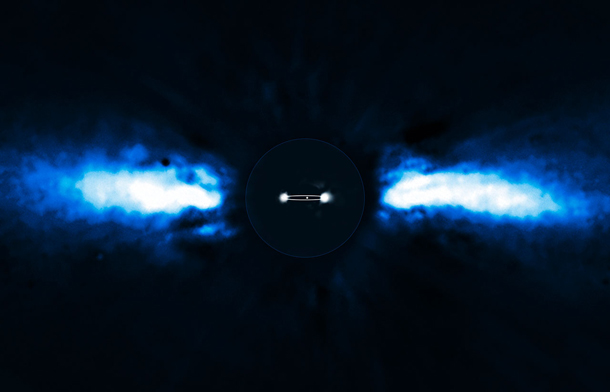
Photo by ESO.
This image is amazing: It’s two superposed pictures showing the Beta Pictoris planet as it was seen in 2003 and 2009, during which time it had actually moved from one side of the star to the other! This made it easier to nail down the size and shape of the planet’s orbit (which is drawn in to give you some scale). Interestingly, a picture taken in 2008 didn’t show the planet: From our vantage point it was too close to the star to see.
An Exoplanet's Baby Picture
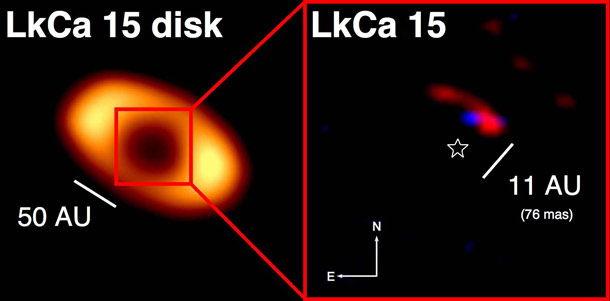
Photo by Kraus and Ireland.
This image is admittedly a bit odd. The picture on the left is of the very young star LkCa-15, and was taken in the far infrared, well outside what the human eye can detect. At that wavelength (850 microns, if you’re curious, and for comparison the human eye can only see out to a wavelength about 0.8 microns) the star is essentially invisible, but you can see a ring-shaped disk of dust surrounding the star. This dust is indicative of a newly-forming planetary system.
On the right are observations made using the Keck telescope in Hawaii. They are in the near infrared, much closer to what the eye can see. The star’s position is labeled, and you can see a swoosh of material colored red around a blue blob (the colors aren’t real; they’ve been added to make this easier to see). The simplest explanation is that the blue blob is actually a planet or a proto-planet—still in the act of forming—about six times more massive than Jupiter. The red streamer is dusty material swirling around the planet. The planet, if that’s what it is, orbits inside the inner edge of the bigger disk, and its gravity may be what’s carving out the big inner hole in the disk. This artist’s illustration should help make this clear.
If this pans out, it will be the first ever direct image taken of a baby planet as it’s still forming.
A Massive Parent
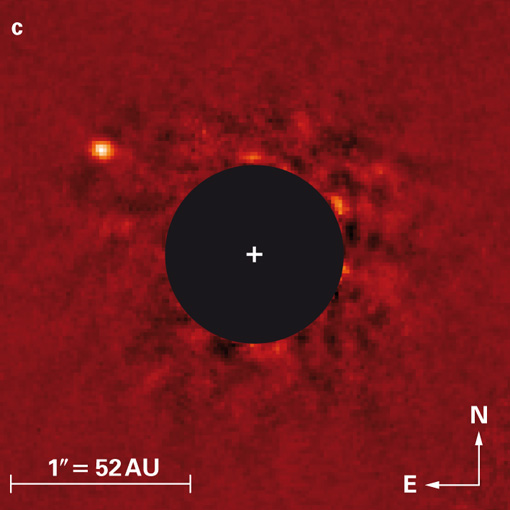
Photo by NAOJ/Subaru/J. Carson (College of Charleston)/T. Currie (University Toronto).
Kappa Andromedae is a massive star about 170 light-years away and easily visible to the unaided eye.* It’s young, perhaps 30 million years old, and this image, taken using the Japanese Subaru telescope, shows it has … something orbiting it. Discovered in early 2012, it’s an object that has a mass just about 13 times that of Jupiter. That puts it very, very close to the upper limit of what a planet is, and at the lower end of it being a brown dwarf, a sort-of failed star. We can’t say for sure if it’s a planet or not.
When they’re this young, planets glow due to the heat of their formation, and they cool with time. A more massive planet glows brighter, so knowing the age of the system is critical to knowing the mass of the planet. If the star system is a bit younger, the object may have less mass than estimated, and be a true planet. One model indicates this may be the case, but we just can’t be completely positive. In a sense, that makes this object even more important: It’s a test of our methods. Even if it turns out to be more like a brown dwarf, it will have helped us refine our models which will make future planet hunting more accurate.
Correction, Nov. 19, 2012: This post originally stated that Kappa Andromedae is 50 light-years away. It is 50 parsecs, or 170 light-years, away.
